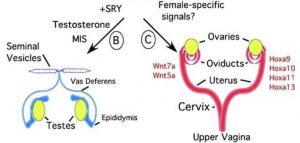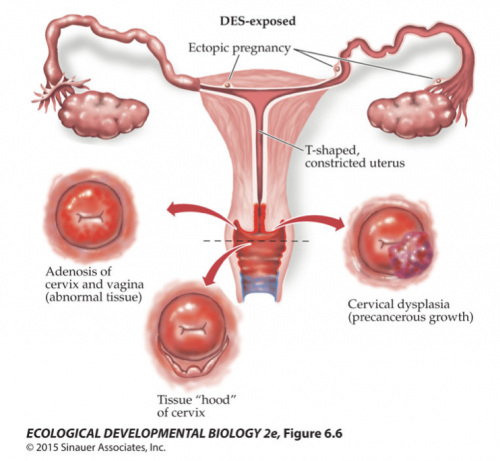A human embryo at the 4th week of development is just a tiny bean with a length measured in millimeters, but at this time all kinds of remarkable features are starting to develop. This week in class I talked about urogenital development, which involves forming an array of incredibly delicate, thin tubes from a structure called the urogenital ridge, a thickening of an embryonic membrane which will eventually form a succession of kidneys, the pronephros, mesonephros, and metanephros, only the last persisting into adulthood. The key feature for the story I was telling, though, is that they formed something called the mesonephric duct, and then the paramesonephric duct which parallels it. Another name for the mesonephric duct is the Wolffian duct, and the paramesonephric duct is called the Müllerian duct (personally, I don’t care for the self-serving names given to critical bits of the developing embryo by 19th century men, but it’s what still persists in the embryo. So it goes.)
Both of these ducts are associated with the bipotential or indifferent gonad. There are no sexual differences in embryos this young.
The sex differences emerge later, in response to differential signals. The Müllerian ducts degenerate in males, while the Wolffian ducts persist. In females, the Müllerian ducts persist, while the Wolffian ducts fade away. The bipotential gonad associates with the remaining duct and differentiates into testes or ovaries.
I’ll refrain from delving deeper into the details. My point is that these minuscule ducts and tissues form very early, and are going to expand to form critical, elaborate structures necessary for human fertility. They’re fragile. You really don’t want to perturb the signals and processes going on in a one month old embryo, especially since you may not see the consequences for 15 or 20 years.
In 1941, pharmaceutical companies started to market a synthetic drug with properties similar to estrogen, called diethylstilbesterol, or DES. It wasn’t patented, so anyone could make and sell it, and they pushed it hard to pregnant women. There was weak evidence that it could help sustain pregnancies in women with low progesterone levels, so sure, let’s market it as “routine prophylaxis in ALL pregnancies.” About 4 million pregnant women took this stuff at the suggestion of their doctors, between 1941 and 1971, when it was finally banned.
Think about that. This was an endocrine disruptor, term that wasn’t invented until the 1990s, but everyone knew then that it would have some kind of effect, since it was a functional analog of estrogen. So they gave it to pregnant women, and by that means delivered a potent hormonal signal to their embryos at a time when they were carefully assembling those delicate little tubes. Worse, they knew that high doses given to mice and hamsters caused mammary, cervical, vaginal, and uterine cancers in adult females, and that adult males developed lung cancers, which ought to have set off all kinds of alarm bells. Any tissue that was sensitive to estrogen could be provoked to turn cancerous with DES.
Just for dessert, it was determined in 1953 that DES did nothing to maintain at risk pregnancies. They continued to prescribe the stuff. Just in case, you know.
For additional profit, they also marketed it as a growth hormone for livestock. That continued until it was eventually banned for that purpose in 1979.
Here’s the structure of this potent little molecule.

A is DES; B is estrogen; C is BPA, the common, heavily used plasticizer that we now know is an endocrine disruptor.
You might be wondering what happened to those 4 million women who took the drug. They were fine! Humans and other primates seem to be more resistant to the carcinogenic effects of DES, and they were taking much lower doses than those poor rodents in testing labs who were given massive doses of the drug.
And what about the millions of boomer babies who were doped with it in utero? Again, mostly fine — this is the thing about endocrine disruptors, they tend not to have the gross teratogenic effects we associate with chemicals that cause significant birth defects, like thalidomide. They’re more subtle. They perturb the balance of internal organ systems, and in this case, cause problems in the physiology of reproductive organs, which may lead to fertility issues or some kinds of cancers. I emphasize may because I know DES-exposed people who have had children and are cancer-free; it’s more a matter of letting their gynecologists know to keep an eye on potential warning signs.
But it can go very wrong.
DES is still used in experimental studies because it’s such an interesting molecule. Regular readers probably know about the importance of Hox genes; these are genes expressed along the body axis in pretty much all animals that defined anterior-posterior structures. The same genes also get re-expressed to define the proximal-distal axis of the tetrapod limb. They seem to be a handy-dandy molecular tool for establishing tissue identities along a line.
Here’s another instance of Hox genes defining position on an organ: they’re re-expressed in the Müllerian ducts, which become the fallopian tubes of adult women.
Hoxa9 is expressed throughout the oviduct, Hoxa13 in only the cervix, and Hoxa11 and Hoxa10 in between, forming a kind of positional coding system. This is really neat! I like finding examples of molecular recycling in the evolution of developing systems.
What isn’t so neat is that DES downregulates Hoxa10 by inhibiting an important signaling molecule, Wnt7a, creating coding ambiguities in the structure of that delicate little tube. That leads to poor cell specification and disorganized tissue, erasing what should be clear, sharp boundaries in the organ, which may then be expressed in dysplasias, increasing the odds of cancer.
As if that weren’t enough, we don’t really know what perturbing these signaling pathways does to other developing organs, like the brain. Also, DES affects methylation/demethylation of the genome, so it may have transgenerational effects — pregnant women who took DES may have messed up their children, but there is some evidence (weak, I think) that it also affects their grandchildren.
But wait! It’s banned, so we shouldn’t have to worry about it anymore! That’s partly true, but look at the diagram of the molecules above. Estrogen and DES share similarities to another molecule, bisphenol A, a ubiquitous plasticizer used to make plastic materials less brittle. BPA is found in your food packaging. It lines the interior of aluminum cans. Any plastic you have that is at all flexible has been treated with plasticizers, like BPA or phthalates. It’s leaching into your food and your general environment, and it does not go away. The US has banned its use in baby bottles and baby formula packaging, but not from all your snack food packages and your phones.
If you’re of a certain age, you might recall those commercials for a dishwashing detergent that announced, “you’re soaking in it!“, as if that meant the stuff must be safe. We ought to be aware that capitalist industries have us all soaking in a gentle bath of toxic chemicals right now, and it’s not safe.







A more subtle effect is the alteration of the commensal biota in the gastrointestinal tract- we have co-evolved with the stuff and many metabolites must cross the membranes and enter the bloodstream.
The major changes in eating habits during different parts of history and prehistory must have had some effects but with only skeletal remains it is hard to compare populations across time.
On top of that, microplastics are now everywhere.
This dosing chart – holy hell how did any children develop normally. Maybe inaccessibility of medical care(?) in the US shouldn’t always be a considered a bad thing.
https://www.hormonesmatter.com/wp-content/uploads/2017/12/DES-Dosing-1953-2.jpg
Wouldn’t recommend the website I found this at.
But …. but … when we flush our medication-laden wastes down the toilet, it all just disappears, right? I mean, the water treatment plants remove all of it before it enters streams, groundwater aquifers and the oceans, right? And those three-eyed fish are just a Simpsons joke, right?
Just dropping by to express some amazement at the idea of an “ecological developmental biology” course. When I was a young life sciences student those departments were pretty much as far apart as two entities could be while staying within the School of Life Sciences. Though of course OP demonstrates exactly how topical it is.
The inside of cans is generally lined with epoxy. Which is indeed made from bisphenol A (or F) and epichlorohydrin. But made from is not the same as is. I don’t know about the US, but all the epoxy makers in the EU agreed decades ago to use an excess of epichlorohydrin in this reaction, so that remaining bisphenol A is in the order of 10 ppm. This reaction product is epoxy resin. Which is generally cross-linked with amines to form cured epoxy. Last time I submitted a cured epoxy for (biocompatibility) analysis I don’t recall they even detected any BPA. And that was for a bog-standard laminating epoxy. Stuff that is made for food contact generally requires higher grade purity base materials and what is called “good manufacturing practice” (i.e. keeping the stuff where the chemistry is done really clean).
Encouragingly, last year I bought a couple of food containers in Italy and they were prominently labeled BISPHENOL FREE, so it seems that at least some companies are taking the problem seriously.
Of course, that’s just one of the many holes in the dike:
https://www.nature.com/articles/d41586-024-00805-2
and as Birgerjohansson reminds us, regarding microplastics… oy. We are indeed soaking in the stuff, eating it, breathing it, and so on.
Yes, we’re dealing with trace amounts in any one source. The problem is that there are so many sources, and so many biological targets, and so little information about the timing and dosages that can cause deleterious effects. I trust that engineers and chemists are doing their best to minimize exposure, but minimal is not the same as zero.
Careful you might be giving the force-birth clique ammunition.
I know a man whose mother took DES while she was pregnant with him. He’s got only one kidney and it’s undersized. He’s in his late 60’s- early 70’s now and hanging in there, thankfully.
pz@7: Minimal is not zero, but we’re moving in the right direction.
Some years ago I ditched plastic containers and switched to glass jars to store leftovers in the fridge. Easy to clean, they don’t take on flavors, are not easily damaged and they keep food longer than plastic. I’ve got a couple of them, and I expect they’ll outlast me.
Recently the shop where I usually go to get loose tea introduced “bring your own” packaging. So I can take in my old tea tin and have them fill it up. As soon as I find a reliable way to keep the lid on when it’s bouncing around in my bike bag, that’s what I’ll do.
I read this with great interest and I hope that PZ reads this.
After having many UTIs during my teens, a particularly bad one during my college years put me into the University Med School ER. There, the radiology techs were agog to see that I have two ureters on one side, both extending from the kidney and entering the bladder very close to each other. It was determined that when one swelled because of an infection, it blocked the other one, causing reflux and making the infection worse.
Fast forward to 1990. My 4 yr old daughter was having frequent UTIs. It was determined that she had one ureter that was too long and that it attached to the bladder in a very inappropriate place. She had surgery to shorten and re-implant the ureter.
It worked fine for 4-5 years, when tests showed that the ureter had shriveled and so had the kidney on that side.
She has done well with one kidney, except for some problems during pregnancy. She still is plagued with frequent UTIs.
I was born in 1957, so I have no idea whether my mother took DES. She was 43 when I was born (her first and only pregnancy), so it’s very possible that it could have been prescribed.
To add to the mystery, one pediatric urologist who examined my daughter asked me a strange question. He asked about similar urinary system problems in our family, then asked about hearing deficits/deafness in our family.
My jaw dropped. My paternal grandmother was deaf from birth, yet successfully raised 6 children.
I found my Dad when I was 34. When we were catching up on health questions and I mentioned the ureter and UTI problems, he gave me a list of women in his family who had similar issues, and several of them also had hearing problems.
I was diagnosed with Menier’s a few years later, and by now, I’m using powerful hearing aids.
My daughter’s urologist explained that he was working on research showing that abnormalities in both the urinary and the hearing systems may be related since those two systems are formed in the embryo at the same time. Thus, his odd question.
That was a long time ago. PZ, can you tell me whether this hypothesis was ever proven?
I don’t know. There are all kinds of surprising connections, but I haven’t heard of that one specifically — I’ll check a few sources when I get back to my office.
Regarding whether there is BPA lining aluminum cans, this straight from the horse’s mouth: https://www.coca-cola.ca/faqs/coca-cola-faqs-health/do-coca-cola-cans-and-bottles-contain-bpa#:~:text=Bisphenol%20A%20(BPA)%20is%20a,taste%20of%20the%20beverage%20inside.
Has any company ever said that the teeny tiny amount of a nasty chemical in their products has a teeny-tiny amount of risk? No, it’s always zero risk.
I remember an incident in the early days of zebrafish research when we briefly switched brands of disposable petri dishes, and started seeing all kinds of anomalies in our embryos. We did some comparison shopping and discovered that some brands would leach something into the water. We didn’t bother trying to figure out what, we just stopped using the perfectly sterile, widely used brand forevermore.
There was also a study that tested polystyrene mouse cages by filling them with water and leaving them for a week — the water absorbed something that made it toxic to mouse cultures.
So cages, petri dishes and other objects that may influence embryo development should optimally be made by something like stainless steel or ceramic?
PZ Myers @ #14 — Would they say “no risk”…literally? Hard to imagine the lawyers letting them be so categorical. I would think they might say “safe” or “acceptable risk” or sone other equivocal hand waving.
Most of those seem to be made from polystyrene. So probably an additive from the polystyrene that leaches out. At a guess, a UV stabilizer. Those tend to be pretty nasty. I see more and more of them being banned in the EU under REACH. Or an antioxidant.
See “Extraction of Additives from Polystyrene and Subsequent Analysis” by Susan H. Smith (no relation), who found 15 additives when analyzing 8 formulations of polystyrene.
As we have genes for a vestigal tail, it is not surprising these environmental factors occasionally activate them.
Also, the unusual development of features that generally are gender-dependent will probably increase with all the things floating around in the environment.
Is it possible that gender dysphoria / transgenderism is caused by endocrine disruptors? I don’t remember ever seeing or hearing much about transgenderism when I was in college (late 60s).
Wow, not even 20 comments in and “transgenderism” shows up 🙄